By Christine Kim, Galaxy
Compiled by: Baishui, Golden Finance
Overview
There are over 50 non-crypto companies that have built products and services on Ethereum or Ethereum L2. These companies include fashion brands such as Louis Vuitton and Adidas, as well as financial institutions such as Deutsche Bank and Paypal. These products and services notably do not include those related to general market infrastructure such as cryptocurrency trading, custody, auditing, and compliance. Instead, they are related to crypto-specific infrastructure and use cases such as NFTs, RWAs, Web3 developer tools, and L2s. Of the 20 financial institutions that have built crypto-specific infrastructure and applications, 10 are banks, most of which issue RWAs on Ethereum. This report aims to highlight the early and major use cases of Ethereum used by traditional companies and institutions.
Preface
For the purpose of this report, the main sectors of the crypto industry can be divided into three categories:
General Infrastructure – Companies that provide cryptocurrency and blockchain-related products and services that are not unique or exclusive to the crypto industry, such as general market infrastructure (i.e. exchanges, market makers, asset management) and general business support (i.e. banking, accounting, consulting, compliance).
Crypto-specific infrastructure – Companies that provide crypto-unique and proprietary products and services. For example, this includes companies involved in mining, staking, and building on-chain oracles, which are responsible for infrastructure that is only useful in the crypto and blockchain context.
Crypto use cases and applications – Companies that are building consumer applications that run in whole or in part on the blockchain. For example, a decentralized exchange automatically executes cryptocurrency trades on the blockchain without relying on a third-party intermediary.
Rather than expanding their existing suite of applications and services to support cryptocurrencies, traditional companies are taking the next step by innovating new products and services that can only be powered by blockchain. Moreover, many of these companies (at least 55 of them) are innovating on public blockchains such as Ethereum and Ethereum L2, such as Polygon, Arbitrum, and Base.
Below is a market map of 55 non-crypto native companies that have or are building crypto-specific infrastructure and applications on Ethereum and Ethereum L2.
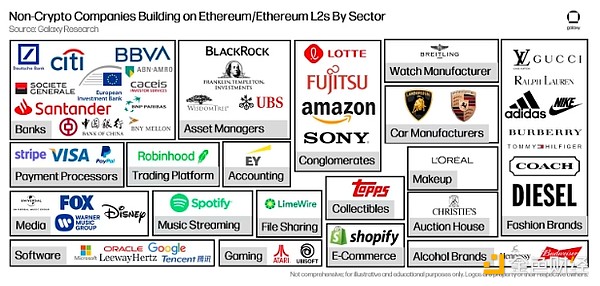
Of these 55 companies, at least 23 have issued NFTs on Ethereum or Ethereum L2.
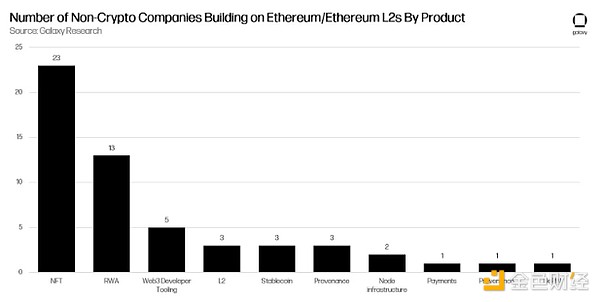
While most companies are building directly on Ethereum, at least 17 have or are attempting to build across multiple general-purpose blockchains and Layer-2 Rollups.
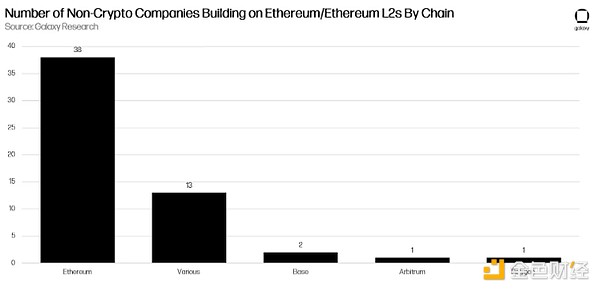
RWA on Ethereum
One of the most common types of non-crypto companies in the Ethereum ecosystem is financial institutions, such as banks, asset managers, payment processors, trading platforms, and accounting firms. Of the 20 financial institutions identified as having built crypto-specific infrastructure and applications, 13 are issuing RWAs on Ethereum and Ethereum L2. Types of RWAs issued on-chain include money market funds (such as the Franklin OnChain U.S. Government Money Fund) and government bonds issued by the European Investment Bank, among others.
Ethereum is the top blockchain for issuing tokenized assets, with a total RWA value of almost ten times that of the next most popular RWA blockchain, Stellar. ZKsync, a Layer-2 rollup built on Ethereum, has a higher number and total value of RWA issued on its chain than Stellar. Six of the top 10 protocols issuing RWAs are Ethereum or Ethereum L2.
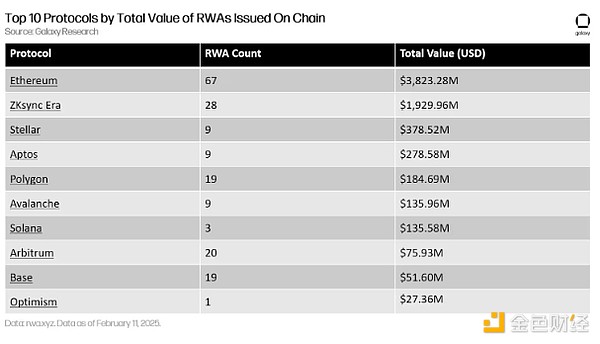
As of February 11, 2025, the third-largest tokenized fund across all blockchains is BlackRock’s U.S. Dollar Institutional Digital Liquidity Fund (BUIDL). Launched in March 2024, BUIDL offers investors U.S. dollar returns with the benefits of instant transparent settlement and interoperability between traditional and decentralized financial markets. Robert Mitchnick, head of digital assets at BlackRock, said in March: “Through tokenization, we are taking traditional financial investment exposure and wrapping it in a crypto-native package.”
BlackRock, the world’s largest asset management company, partnered with tokenization platform Securitize and US financial services company Bank of New York Mellon to launch BUIDL on Ethereum for the first time. Since March last year, BlackRock has expanded the fund to five additional protocols beyond Ethereum, three of which are Ethereum L2.
The value of RWAs issued on Ethereum alone has tripled in the past year. According to rwa.xyz, over 160 RWAs have been issued on Ethereum and are held in 60,000 unique active wallet addresses. These numbers do not include stablecoins.
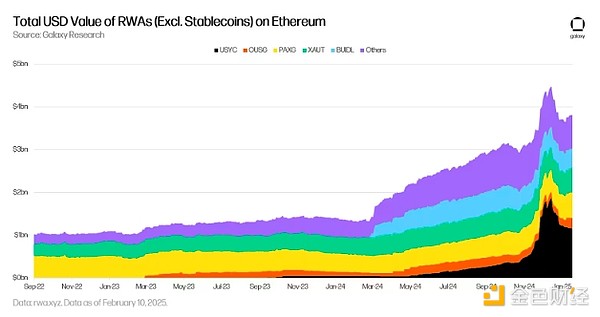
Although smaller in number, a subset of financial institutions dedicated to RWAs and tokenization are also developing their own stablecoins. Payment processor PayPal first launched its own dollar-pegged stablecoin PYUSD on Ethereum in August 2023. PayPal has since expanded the distribution of PYUSD to Solana. Trading platform Robinhood, in partnership with many other crypto-native institutions such as Galaxy Digital, Kraken, Nuvei, Anchorage, Bullish, and Paxos, also launched its own dollar-pegged stablecoin USDG on Ethereum in November 2024.
The total circulating supply of stablecoins on Ethereum has increased by 70% over the past year. These stablecoins vary in collateral mix and design type, but the vast majority are USD-pegged instruments that hold high-quality liquid assets (HQLA) as collateral. As of February 11, 2025, Ethereum accounts for more than 50% of the total stablecoin market.
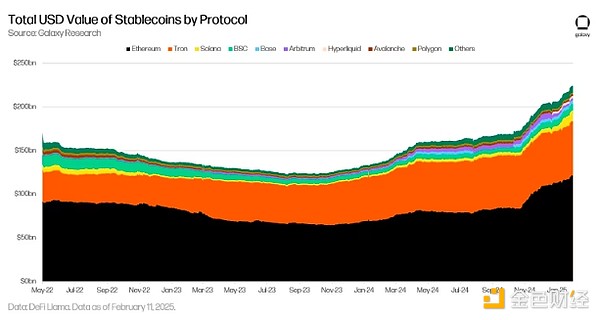
Data from Galaxy Research shows that by 2025, the total supply of stablecoins will double to more than $400 billion. This year, a catalyst for the accelerated launch of new stablecoins backed by traditional financial partners is Stripe's acquisition of stablecoin payment platform Bridge for $1 billion in 2024. Regarding the acquisition, Stripe CEO Patrick Collison said: "Stablecoins are the room temperature superconductors of financial services. Thanks to stablecoins, global businesses will benefit from significant improvements in speed, coverage, and cost in the coming years."
In the United States, another catalyst for the adoption of RWAs and stablecoins is the regulatory environment. U.S. Securities and Exchange Commission (SEC) Commissioner Hester Peirce issued a statement on Tuesday, February 4, 2025, outlining specific priorities and topics related to the digital asset industry that the Commission may address, and the ninth item on her list emphasized the modernization of traditional finance through tokenization. "The working group also plans to study the intersection of cryptocurrencies with clearing agency and transfer agent rules. "We will continue to work with market participants who are interested in tokenizing securities or otherwise using blockchain technology to modernize traditional financial markets," the statement reads.
RWAs and stablecoins are crypto-native use cases that are rapidly finding product-market fit in traditional financial institutions. As the most decentralized general-purpose blockchain with the broadest reach of crypto-native users and the longest network uptime, Ethereum is the gateway many institutions use to incubate and launch financial-focused crypto services and products.
Scalable blockchain infrastructure
While Ethereum is a gateway for many financial institutions and non-crypto companies to leverage cryptocurrency and blockchain technology, it is not a protocol that can scale with new use cases for blockchain. Compared to blockchains like Solana, Ethereum has poor performance, slow block times, and high transaction fees. Rather than sacrificing the network’s resilience and security (a byproduct of the network’s decentralization) for speed, Ethereum protocol developers are committed to making Ethereum a hub for Layer 2 rollups. Rollups are blockchain infrastructure that can inherit Ethereum’s security and scale to millions of new users.
Not only are non-crypto companies advancing crypto use cases on Ethereum, such as tokenization, but they are also investing in the infrastructure needed to support these use cases for a wider audience than crypto-native users. Germany’s largest bank, Deutsche Bank, is working with Matter Labs, the team that built the ZKSync rollup, to develop new rollups on Ethereum. Codenamed Project DAMA 2, the Rollup is part of a broader initiative led by the Monetary Authority of Singapore (MAS) and 24 other financial institutions around the world to explore the use cases of public blockchains in global finance.
The main motivation for Deutsche Bank’s L2 is to create a blockchain infrastructure that is scalable, auditable, transparent, and interoperable with regulated platforms and financial services. “Institutions looking to build on-chain are turning to ZKSync for the ability to build in Web3 without compromise. ZKSync provides institutions with a customizable architecture to build customized solutions that achieve privacy, scalability, and interoperability with other private and public blockchains,” said Alex Gluchowski, co-inventor of ZKSync, on the motivation for Deutsche Bank’s L2.
Financial institutions such as Deutsche Bank are developing scalable blockchain infrastructure that is also customizable and compliant with regional regulations on Ethereum. However, the appeal of scalable and customizable blockchain infrastructure is not limited to financial use cases.
Japanese conglomerate Sony recently launched its own rollup on Ethereum using the OP technology stack. Their motivation for creating and operating their own general rollup is to support a wider ecosystem of gaming, financial, and entertainment applications. Regarding Sony’s L2 Soneium, Jun Watanabe, Chairman of Sony Blockchain Solutions Lab, said: “I believe that developing comprehensive blockchain-based Web3 solutions is very important to the Sony Group, which has a wide range of businesses under the motto ‘to make the world emotional through the power of creativity and technology.’”
Since Soneium’s launch, the protocol has faced backlash over Sony’s oversight of on-chain activity, particularly the launch of memecoin, which resulted in restrictions on token transfers and blacklisted addresses. While the incident has raised questions about the level of control that businesses should have over the rollups they build on permissionless infrastructure like Ethereum, it has also highlighted the commitment of one of the world’s largest conglomerates to finding answers to these questions. Sony, through the launch of Soneium, is investing in new digital experiences and applications on Ethereum, and by launching a rollup on Ethereum, it speaks volumes about the potential value of the Ethereum blockspace and the scalable blockchain infrastructure built on it.
Gaming on Ethereum L2
NFTs are the main use case for traditional companies, mainly luxury fashion brands such as Louis Vuitton and Coach, and luxury car manufacturers such as Porsche and Lamborghini. Most of the NFTs issued by these companies were minted between 2021 and 2023, at the peak of the NFT craze. Given the decline in NFT reserve prices over the past few years, many companies are no longer actively issuing NFTs on Ethereum and Ethereum L2 in 2025.
The few companies still actively issuing NFTs on Ethereum in 2025 are doing so in the context of game development, and almost entirely on Ethereum L2, not Ethereum itself.
In July 2024, video game giant Atari deployed two classic arcade games, "Asteroids" and "Breakout," on Ethereum's optimistic rollup Base, operated by Coinbase. By the end of August 2024, gamers could earn rewards, mint exclusive Atari NFTs, and redeem physical goods on Base. A few months after Atari's foray into on-chain gaming, in October 2024, Lamborghini announced a partnership with Web3 gaming company Animoca Brands to launch a digital collectibles platform called FastForWorld.
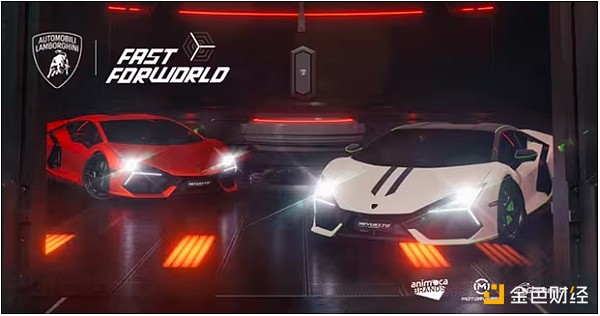
FastForWorld enables gamers to buy, sell and drive Lamborghini vehicles across a range of games developed by Animoca Brands, including Torque Drift 2, REVV Racing, Motorverse Hub and FastForWorld’s proprietary experiences. The press release describes the partnership as “the first time Lamborghini has made its iconic vehicles interoperable in-game on the blockchain.”
It was later revealed that FastForWorld's in-game assets would be minted on Base. The first version of the platform launched on November 7, 2024 and is still under active development, with additional expansions to the FastForWorld platform expected to be announced in 2025.
Recently, on January 7, 2025, Lotte Group, one of the top five Korean business groups, announced a deeper partnership with the Arbitrum Foundation and Offchain Labs to build Lotte's metaverse gaming platform "Caliverse" on the Ethereum aggregate Arbitrum. The already launched Caliverse allows users to shop, attend virtual concerts and play games on its platform. "Together with Arbitrum, the most trusted blockchain, we are excited to take the first step in the blockchain world with Lotte Caliverse. We will leverage Lotte's successful history in the retail industry to provide excellent products and services to more than 40 million people," said Kima Kim, CEO of Caliverse, when talking about the cooperation with Arbitrum. During the 2025 Consumer Electronics Show (CES) in Las Vegas, the United States, the Caliverse team announced plans to launch virtual reality and 3D movie features on its platform in the first half of 2025.
Most notably, non-crypto native companies such as Atari, Lamborghini, and Rakuten’s Caliverse are continuing to invest and develop NFTs in the context of larger on-chain gaming applications. Blockchain-based games can require frequent on-chain transactions, which can also lead to expensive fees and network congestion. For this reason, these companies are building their games on Ethereum L2 to take advantage of the scaling benefits of Ethereum’s rollup-centric architecture.
“Arbitrum’s blockchain is the ideal home for Caliverse thanks to industry-leading 250 millisecond block times, enabling seamless virtual worlds and gaming use cases,” said Steven Goldfeder, co-founder and CEO of Offchain Labs.
in conclusion
NFTs and RWAs are the leading use cases for Ethereum among non-crypto native companies and institutions. Among the companies issuing NFTs in the Ethereum ecosystem, the most active in 2025 were issuing NFTs in on-chain gaming applications built on Ethereum L2. This highlights how the scalability gains brought by L2 can help support crypto-native use cases that require frequent on-chain interactions, such as games between major retail brands and companies. Ethereum’s focus on scaling its infrastructure through Rollups also provides an opportunity for early adopters of the technology in traditional finance and other industry sectors to lead the way in non-speculative use cases for crypto by creating customizable and compliant infrastructure for these use cases. Finally, Ethereum remains the blockchain of choice for traditional financial companies to issue RWAs and stablecoins. It is expected that key partnerships and acquisitions established in 2024 will drive new progress in the adoption of stablecoins in 2025.















